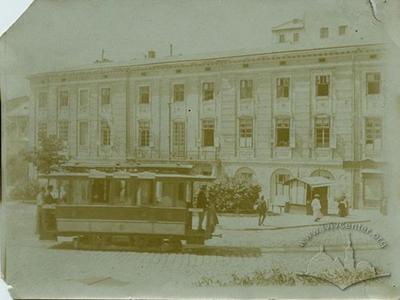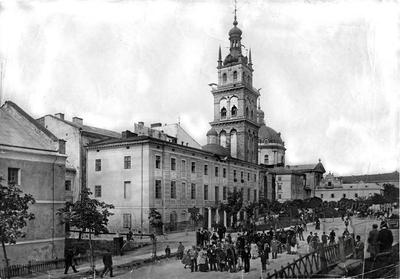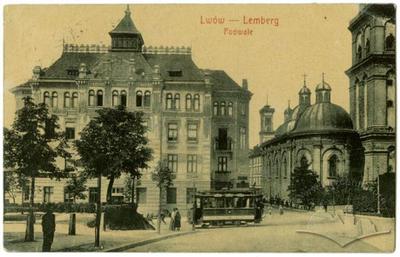Vul. Ruska, 20 – former gyms of "Sokil-Batko" society
The building of the former sports society "Dnister" was built in 1905–1906 by a construction company of Ivan Levynskyi. The architects were Tadeusz Obmiński and Oleksandr Lushpynskyi. It is a monument of architecture and urban planning of local significance: protection number М-250.
Presently, it is a communal property (it is owned by a local community of Lviv represented by Lviv City Council). It is used by a medical institution Municipal Polyclinic No 1, and the sports society "Ukrayina."
Architecture
Historically, the building had cultural educational, commercial, sporting and residential functions. It is a corner building with the façades facing Ruska and Pidvalna streets. It has three floors, and an asymmetrical complex planning layout. The system of inside premises is composed around a spacious courtyard.
In the right wing, on the ground floor, there is a gym that used to be run by the "Sokil-Batko" society. The second gym in the same lateral wing is presently used as a center of physical therapy and massage. The former administrative building of the "Sokil-Batko" is used by a pharmacy store today. The main gym and the massage room still have preserved some gymnastics equipment pieces of the early 20th c.
Related Places
Vul. Ruska, 20 – First Municipal Polyclinic (former Dnister Insurance Company Building)
Show full description
Personalities
Yaroslav Blahitka — a leading gymnast of the "Sokil-Batko" in the 1930s.
Alfred Budzynovskyi— a head of Ukrainian gymnastics and sports society "Sokil-Batko" (1901–1908 рр.). Due to his efforts, the gyms
in "Dnister" were rented by the sports society.
Josyf (Josafat) Kotsylovskyi— Doctor of Theology, a bishop in Przemysl. Weight-lifter, and
a gymnast. In 1896, in Prague, he passed an exam to qualify as a teacher
of physical exercise. Chief for gymnastics classes in the gyms of "Sokil-Batko" in the "Dnister" building.
Yevhen Oryshchyn — a gymnast, well known in the 1930s. He was training
in the gyms of "Sokil-Batko" in the building of "Dnister." Later, a highest international qualification judge, worked at Olympics in Mexico (1968), in Munich (1972), in Montreal (1976), and in Los Angeles (1984).
Viktor Sydiak — a sabre fencer, Merited Master of Sports, champion of the 19th
Olympics in Mexico (1968). He started his training in the
gym of the "Spartak" society on vul. Ruska, 20.
Vasyl Stankovych— a foil fencer, Merited Master of Sports, silver medal winner at the 19th Olympics in Mexico (1968). He started his training in the gym of the "Spartak" society on vul. Ruska, 20.
Yana Shemiakina — a sabre fencer, champion of the 30th
Olympics in London (2012). She is the only lady among Ukrainian champions at London Olympics coming from Lviv. She started her training in the gym of the "Spartak" society on vul. Ruska, 20.
Sources
- State Archive of Lviv Oblast (DALO) 2/2/3806.
- Діло, 1906, №223, 3, 17.
- Діло, 1906, №227, 3, 21.
- Ілюстрований народний календар товариства "Просвіта" на рік звичайний 1907 (Львів, 1906).
- Б. Є. Трохим'як, Фізичне виховання і спортивний рух у Західній Україні (з початку 30-х років ХІХ ст. до 1939 р.) (Київ: ІЗИН, 1997).
- Ігор Жук, "Будинок товариства "Дністер", Історико-архітектурний атлас Львова, серія ІІ, зошит 1 (Львів: Центр Європи, 1996).
- О. Вацеба, Нариси з історії спортивного руху в Західній Україні (Івано-Франківськ: Лілея-НВ, 1997).
- Ю. Кордіяк, Чемпіони живуть у Львові (Львів: Каменяр, 1980).
By Khrystyna Kharchuk and Ihor Zhuk
Media Archive Materials
Related Pictures










